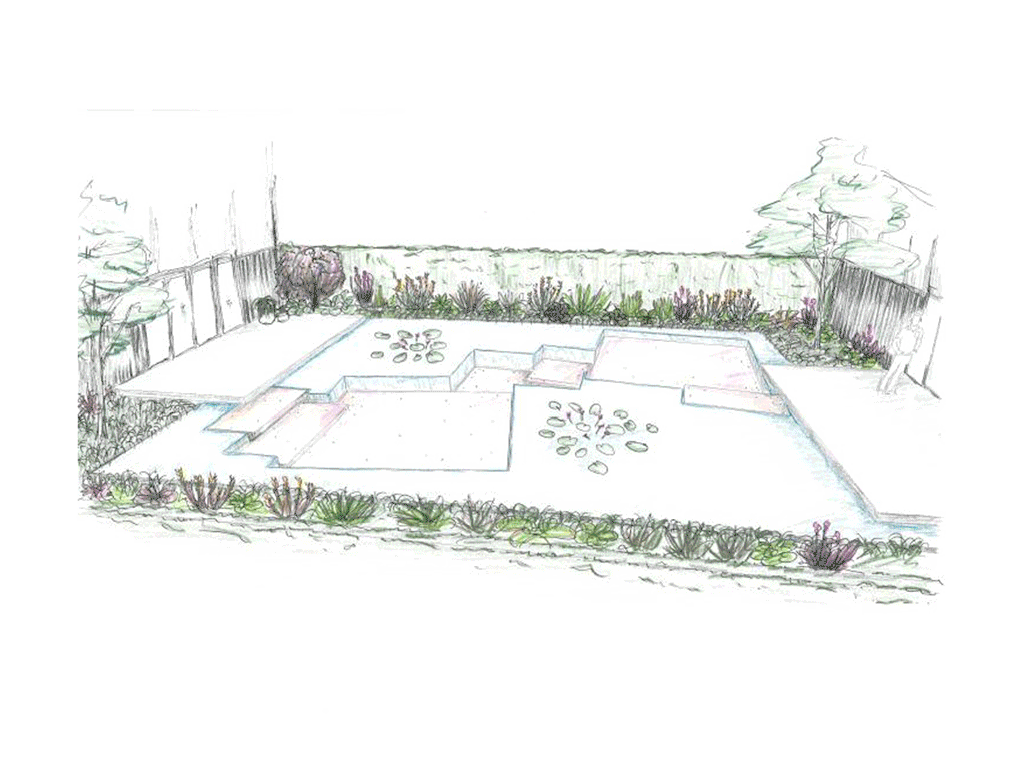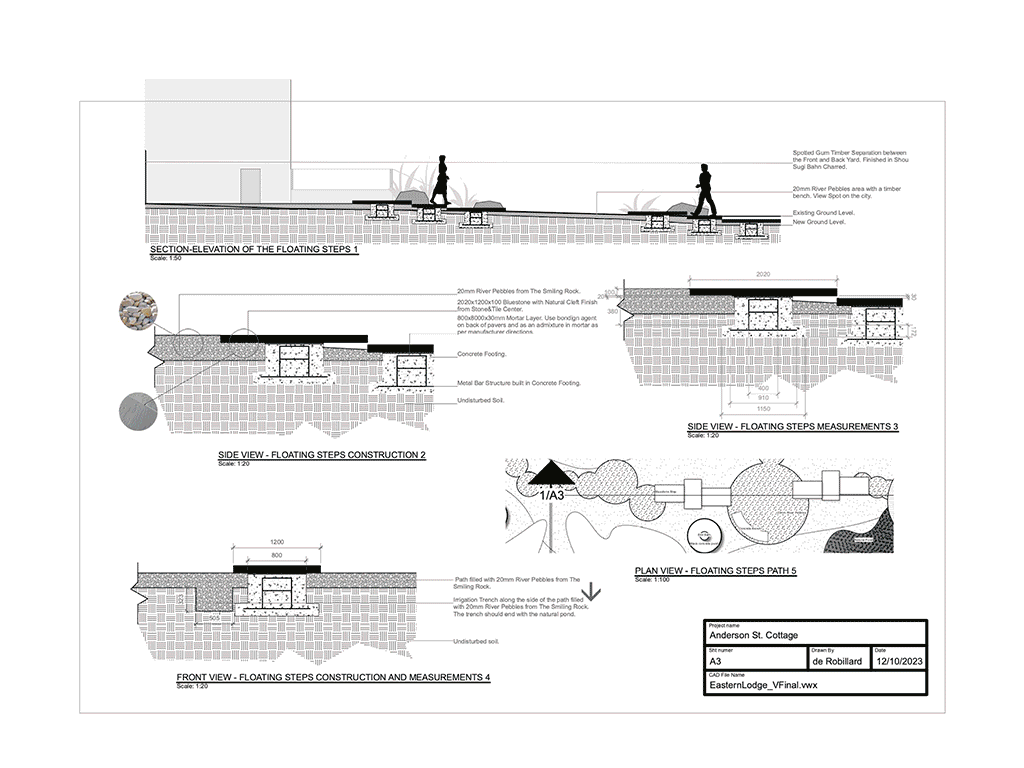
Garden Design Course
Internationally proven, design-led training.
Our design-led approach is built on the unrivalled expertise of our UK partners and has been successfully adapted to the Australian context. Here in Melbourne, the program is firmly established, led by some of Australia’s most respected design and horticulture professionals, with the same high standards that have made our London college Europe’s leading provider of garden design courses.
Over two years and four semesters, students develop the full breadth of professional skills, from planting design, horticulture and CAD, through to construction and business training. The extended course structure allows deeper exploration of specialist subjects, with a particular emphasis on planting design and outdoor living, reflecting the way Australians connect with gardens.
The result is training that’s internationally recognised, but authentically grounded in the needs and opportunities of the Australian landscape design profession.
What you’ll get
-
✺ DESIGN LED TRAINING
A globally recognised program adapted to Australian practice.
-
✺ PRACTICING PROFESSIONALS
Learn directly from designers and horticulturists working in the field.
-
✺ HIGH TUTOR /STUDENT RATIOS
Small groups ensure plenty of personal guidance and feedback.
-
✺ INTENSIVE TRAINING
Two years, four semesters, designed to fast-track your skills.
-
✺SPECIALIST LECTURES
Insights from leading voices across design and horticulture.
-
✺ONGOING MENTORING
Continued support and connection after graduation.
Our Educators
Our two-year Garden Design Program is led by our Australian Director Brent Reid, supported by practising design, horticulture and technical professionals from Australia to ensure you are given the widest possible experience of our industry and the most up-to-date knowledge. Our London colleagues will also bring their unique experience to the course, contributing to the course content, timetable and design experience.
Teena Crawford | Horticulture Lecturer.
A leading horticulturist, consultant and author, Teena Crawford brings a deep understanding of plants to her teaching. She helps LCGD students see planting not just as decoration, but as design — the layer that gives every garden its life and purpose.
Emmaline Bowman | Habitat & Ecology Lecturer
As an award-winning landscape designer and environmental advocate, Emmaline Bowman brings a passion for designing with purpose. Through her teaching, she helps students understand how to create gardens that restore habitat, support biodiversity and strengthen the ecological connections between people and place.
Course Structure
Semester 1
Semester 1 starts with visual communication and hand drawn design production using plans, cross sections and elevations. Techniques combine free-hand line and the addition of texture but also on colour rendering. The techniques will enable students to develop their own visual language as an option for future use. Lectures will examine and discuss alternative techniques and the work of key designers.
As the course moves forward three-dimensional design techniques will be introduced, allowing students to better understand the garden spaces that they will create. A simple design exercise allows students to express ideas but also to understand the quality and character of those spaces through drawing. Design principles are introduced in lecture format together with an introduction to designing with materials and to plants and planting design. Teaching will also explore more practical aspects such as soil science, survey technique, site assessment and the client brief. Garden design history will explore the development of the private garden against a wider cultural background.
The first CAD software is explored through the second design project with block teaching of technique followed by studio support as the project develops. Project 2 concentrates on the process of design and how ideas develop from inspiration to design delivery. Students are encouraged to select inspiration from sources as diverse as painting, sculpture, photography, architecture, textiles or ceramics.
The semester culminates in the production of Project 3, an outline design solution for a given siteand the basis of client-facing design discussion and development. Studio and tutorial teaching becomes a more regular feature of the program at this point and students explore their work in smaller group format through supportive interim critiques, providing formative feedback as the project develops. Two longer term research projects are introduced insemester 1 for delivery in semester 2. The design handbooks ask students to select, analyse anddeconstruct existing design solutions. One handbook concentrates on planting design, the second on construction design. The handbooks also introduce the concept of detailed design production.
Semester 2
Semester 2 starts with a reflective look back at the Outline Design exercise in semester 1. Students will be asked to construct a physical, scale model of their project for comparison with their virtual models. The process of reflective and objective analysis is important for garden designers who often either work
alone or in smaller teams. Students are asked to investigate elements that they might change or develop as part of the review. Lectures at this stage concentrate on construction design with hard materials whilst studio and tutorial teaching concentrates on the production of detailed construction design in support of an outline design project.
The selected garden for the project will be small in scale but include slopes or level changes. Students can explore retaining structures, steps, boundary treatments, paving, lighting and water features through lectures that support their studio and self- directed studies. CAD teaching introduces a second, more powerful tool to support accurate, detailed design work concentrating initially on construction drawings that would deliver information to the landscaping team for costing purposes and for build.
After submission and presentation of the design proposal students will consider the cost of their scheme, working from a guessed total to a finalised detailed total aided by a working contractor. Once again students are invited to reflect on their design thinking once they have developed an awareness of ultimate and realistic costing information, making suggestions as to how their designs might change and develop in the light of this information.
Semester 3
Semester 3 focuses on plants and the process of planting design through lectures and workshops. We will consider issues around soils, a changing climate, sustainability and aftercare alongside inspirational factors such as plant qualities, plant communities, ecological habitat and plant association.
Practical aspects of planting design will also be taught including nursery practice and the production of detailed planting plans and schedules for plant ordering. Students will learn how to compare and use traditional planting design approaches with naturalistic and wild landscape design solutions. We will also visit plant nurseries to explore their services and the difference between both large production and small specialist suppliers.
For studio and tutorial teaching students will work on a residential garden in which they can apply their thinking to diverse planting conditions as well as considering and resolving client requirements. Students will support their design ideas with a detailed design of selected areas delivered in the form of working planting plans and schedules. Students will also learn from practicing designers in key lectures that will explore and analyse design solutions for specific clients and locations. Whilst discussed throughout the course, in this semester we will start to discuss through lectures, business skills specific to landscape design. Students will also be tasked with finding a site for their final semester project and to begin research and site analysis for that location.
Semester 4
In the final semester students will work at a larger scale of at least two acres or more to develop confidence in dealing with the larger scale and appropriate design solutions. Chosen sites can reflect specific interests such as habitat creation, contemporary design, semi- commercial locations or specialist therapeutic landscapes such as hospices and care homes. Selected sites might also relate to specific locations in which students might be based, providing a potential link to future clients.
Students themselves will drive and design the brief to produce design solutions that suit their own ethos and outlook. The central project will explore the concept of master planning for a large-scale proposal supported by construction and planting detail, written specifications and scope of work documentation.
Lectures will cover specialist elements of garden design such as large-scale ornamental or naturalistic planting, woodland or meadow habitats, water, swimming pools, dry landscapes, roof gardens or city spaces. In addition, teaching will turn towards professional practice and issues such as planning, legislation, contracts, fees and charging mechanisms alongside marketing and promotion. Students will graduate with a diverse portfolio of inspirational work at different scales supported by hard and soft detailing that delivers confidence in, and awareness of, their design proposals.
Where this can take you
Graduates go on to start their own design practices, join established studios, or contribute to horticultural projects across Australia and beyond.
Find out more
Enter your details below to download the 2026 prospectus






